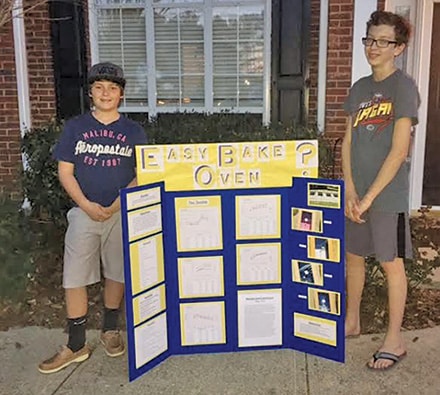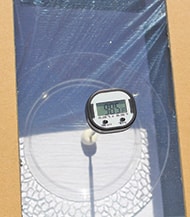
Next door neighbors and friends since the age of three years old, Austin and Hunter teamed up to develop a solar cooker for their science fair project. What question did the thirteen year old, seventh graders want to answer? Austin and Hunter wanted to know what materials cook food fastest using the sun’s rays so that a make-shift oven can be used by people who don’t have money, but could afford them to have a hot meal.
Austin described the process. “Using four boxes, rectangular holes were cut out of the lids and wrapped in plastic wrap. Each box was lined with either red, black, white paper, or tin foil. One marshmallow sat on a clear plastic plate and was placed inside the box. We put the lids on and pierced a digital thermometer through the plastic to measure the temperature of the marshmallow cooking inside.”

Four different tests were conducted, measuring the temperatures every five minutes. “To remove a variable – the angle of the sun – we rotated the order of the boxes, retested, and measured temperatures. One anomaly occurred; a cloud floated over and blocked the sun.” Austin laughed. The boys needed a cloudless sky. “We brought the boxes inside, let them cool, and ate the melted marshmallows. That was one of the best parts of the experiment!”
What did their results show? Tin foil yielded the highest cooking temperatures, the little oven soared up to 106 degrees in thirty minutes. Red was next, with white, and then black coming in last. Austin and Hunter were surprised by their results. “We honestly thought foil would be followed by black because we have learned that black absorbs heat unlike lighter colors. However, after researching our findings, we discovered the color red falls between white and black in the color spectrum and actually heated up faster than tin foil, but maxed out after ten to fifteen minutes.”
Over 150 judges at the 39th Annual Gwinnett County Science Fair scored a variety of projects submitted by elementary, middle, and high school students. After Austin and Hunter won first place at the Dacula Middle School Science Fair, they won first place again at the county level. They even received the Taking the Pulse of the Planet Award, presented by the National Oceanic and Atmospheric Administration (NOAA) and have been invited to submit their project for consideration for the Broadcom MASTERS science award.
“It was very fun working with Hunter.” Austin said. His mother, Marci Moore, also credits Jennifer Sevier, seventh grade gifted science teacher at Dacula Middle School for keeping the students on track with their projects. “She set deadlines to make sure the students completed their projects before the due date. She’s a phenomenal teacher.” The boys look forward to moving on to the State finals.
Pictured: A closer look of solar cooker box construction. A digital thermometer measured the temperature of the marshmallow cooking inside.
Why Science Fair? “Science is about asking questions. We want our students to be well prepared for college and career opportunities because our students can change the world and they’ll be able to think about the world and ask questions,” explained Jonathan Wetherington, Director of Science, Gwinnett County Public Schools in a video interview that recapped the highlights of the county event. Austin and Hunter were among the twenty-five first place winners in various categories that represented twenty-six out of thirty-one middle schools in Gwinnett County.
For more information about the Gwinnett Science and Engineering Innovation Fair and 2017 results for elementary, middle, and high schools, visit www.gwinnettsciencefair.com.


